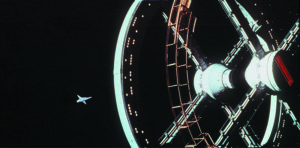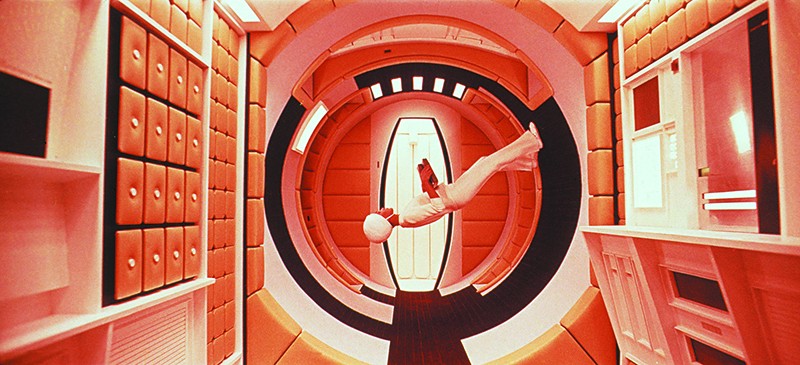13 April 2018 (Perugia, Italy) – In 1968, film-maker Stanley Kubrick and his screenwriting colleague, science-fiction author Arthur C. Clarke, presented 2001: A Space Odyssey. Half a century later, this unprecedentedly detailed speculation about our place in the cosmos and our evolving relationship with technology is regarded as one of the great landmarks in cinema. There has been a recent stream of articles honoring the movie on its 50th birthday, many addressing the film’s respect for scientific rigor.
Piers Bizony (a science journalist, space historian, author, and exhibition organiser) specializes in the topics of outer space, special effects, and movies and he is considered to the definitive expert on 2001. He has produced beautiful, large format books filled with photography, essays, and interviews plus a stream of articles relating to the making of the movie. His classic 2001: Filming the Future (first published in 2000) became the seminal book on the making the movie. It is not just the best collection of information regarding the film, but chronicles the inspiration behind it. He interviewed many members of the team who created 2001, including Arthur C. Clarke, which included special effects supervisors, technical advisors, production designers, model-makers, effects technicians, and contractors. He significantly expanded this into a later book The Making of Stanley Kubrick’s ‘2001: A Space Odyssey‘ published in 2015. Considering there are many books devoted to the films of Kubrick and particularly this film, these are the best place to start.
I reread Making earlier this year and I also pulled a few gems from his tsunami of essays and articles. Mixing that with a recent BBC TV special and an exhibit at the Science Museum in London, herein a few points about the movie.
“Ah … technology and human development: what a mix!”
The influence of 2001 on the design of subsequent space-film hardware and special effects has been pervasive. However, in terms of artistic and philosophical bravura, it has been a harder act to follow. In 2007, director Ridley Scott (of Blade Runner and Alien fame) told a Venice Film Festival audience: “After 2001, old science fiction is dead.”
To be sure, the film’s narrative was ambitious, to say the least. Prehistoric apemen have a mind-altering encounter with an alien black monolith. Four million years later, a giant spacecraft is sent to Jupiter on a mysterious mission. On board are two astronauts, three hibernating scientists and a seemingly sentient computer, HAL 9000. Hovering above Jupiter, another monolith waits.
Monoliths aside, 2001 was prescient in almost all its detailed predictions of twenty-first-century technology. For instance, in August 2011, the Samsung electronics group began a defense against a claim of patent infringement by Apple. Who invented the tablet computer? Apple claimed unique status for its iPad; Samsung presented a frame from 2001.
Note: based on my chat with Florian Mueller, the app developer and technology patent expert who blogged 463 articles about the first Apple/Samsung case (the re-trial starting next week) Samsung noted that the design claimed by Apple had many features in common with that of the tablet shown in the film clip — most notably, a rectangular shape with a display screen, narrow borders, a flat front and a thin form. According to Bizony, in an era when computers still needed large rooms to accommodate them, Kubrick’s special-effects team rigged hidden projectors to enliven devices that looked as though you could hold them in one hand.
And for movie fans: only the need to trim the film’s running length prevented ingenious mock-ups of touch-sensitive gaming screens (which would later be adopted by Sony) and electronic newspapers (which would later be coopted by Steve Jobs) from making the final cut.
Indeed, 2001 got much right about the twenty-first century, including the psychological costs of our reliance on technology. Kubrick’s astronauts look listless inside vehicles perfectly capable of functioning without them. Says Bizony in an essay:
Dialogue in the film is deliberately banal. HAL gets all the best lines, even as he kills off most of his human companions on board the Jupiter-bound spaceship. As our machines smarten up, we will dumb down, Kubrick suggested. The crass human discourse often found on today’s algorithmically clever social-media platforms seems to bear out his pessimism.
I do not think it is a stretch to say that in the film, the surviving astronaut’s final conflict with HAL prefigures a critical problem with today’s artificial-intelligence (AI) systems. How do we optimize them to deliver good outcomes? HAL thinks that the mission to Jupiter is more important than the safety of the spaceship’s crew. Why did no one program that idea out of him? Now, we face similar questions about the automated editorship of our searches and news feeds, and the increasing presence of AI inside semi-autonomous weapons.
We also face the startling fact that 1960s assumptions about the progress of AI were optimistic (Bison notes that computing pioneer Marvin Minsky served as a consultant for 2001). No machine available today can match HAL’s performance. Just look at the YouTube spoofs of “digital personal assistants” reimagined as HAL: Kubrick’s red-eyed genius outsmarts them all.
A shuttle flight attendant walks in zero gravity
Where the film made technical errors, it did so in ways that were flawed rather than merely wrong. Kubrick’s machinery is a matter for nerdish analysis instead of the ridicule usually reserved for outdated fantasies. Rocket experts happily argue about the film’s docking arrangements and control-panel layouts; but none of the machinery is out of bounds in terms of what we could actually achieve.
And Kubrick and Clarke confidently predicted space projects that still lie many years, or decades ahead, 17 years after the film’s eponymous dateline. Famously, Kubrick gave us the most persuasive space station in all of science fiction, a gigantic twin-wheeled “Orbiter Hilton”. It was complete with coffee-vending machines, garish designer chairs in the lounges, phone booths accepting credit cards, and panoramic windows offering spectacular views of the Earth (something so familiar to the film’s spacefarers that they ignore it).
Space planners of the 1960s assumed that artificial gravity would be essential. In the event, the International Space Station was designed for science experiments that depend on cancelling out gravity’s influence, not replicating it.
Note: now the wheel has turned full circle, as we recognize the debilitating effects of long-term weightlessness on the human body. Aerospace engineers are starting to think about how we could make revolving habitats for future deep-space missions, or orbiting hotels for private adventurers.
As for those”corporate” explorers … well, the recent triumphs of Elon Musk’s SpaceX rocket company validate Kubrick’s use of Pan Am as his space-shuttle carrier of choice. Although Pan Am no longer exists, the corporate conquest of the cosmos is under way, just as 2001 predicted. For today’s “orbital entrepreneurs”, the film is not just a beautiful piece of science fiction. It is a technical manifesto – an inspirational call to arms, around which a real commercial space industry is being founded.
“About those black slabs”
Of course, 2001 also suggests some kind of non-terrestrial influence over human progress. After unsatisfactory experiments trying to depict aliens, Kubrick chose only to hint at their presence, allowing those black slabs to stand in for – well, for what, exactly? What I think Kubrick may have been illustrating was how we transitioned from a lesser state of awareness and into something more. The apes saw the world from a primal and survival-based intelligence level. Then, one day, they saw something in a way which they could not describe.
Note: Bizony says some production team members on the movie thought that Kubrick’s point was to make the black slab sudden and out-of-nowhere, so there was no way to not perceive it with intense reactional response, elevating one’s self from a lower conscious level to ultimately realize human potential. The apes realize that one can use objects as weapons and begin to interact with the world in an evolutionary manner. Kubrick was describing the birth of conscious intelligent life.
Bizony’s take on those slabs? Well:
Just as the apes, the bones-as-a-weapon realization and the rocky, wild and unconquered landscape acted as an allegory for where conscious awareness found itself, the ending “room” is the same. We see a fully civilized, cultured man surrounded by a pleasant bright white light in an ordered and structured room. Whereas before the sun was the only source of light, now the source is fluorescent and man-made. The world in which the apes found themselves was completely out of their control and foreign, whereas the room the ‘futureman’ finds himself within is completely of his (in the species sense) own creation and understanding.
Today, we know that planetary systems orbiting other suns are the rule rather than the exception, and that prebiotic molecules suffuse the vast, interstellar clouds of dust and gas from which new stars and planets are born. Have any of these molecules sparked into life on other worlds, perhaps giving rise to intelligent entities? If so, might some of them be more advanced than we are? Should we watch out for superior “aliens” closer to home, and guard against AI systems one day supplanting us in the evolutionary story yet to unfold? Or does the absence of anything like HAL, even after 50 years, suggest that there is, after all, something fundamental about intelligence that is impossible to replicate inside a machine?
Until we know the answers to such profound questions, 2001: A Space Odyssey cannot stale.

